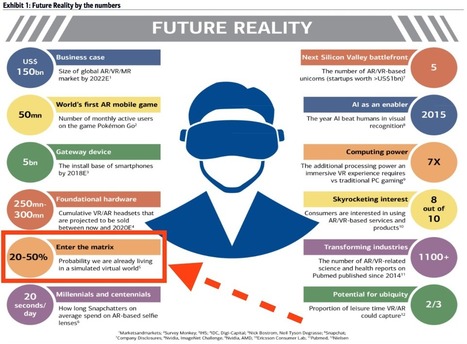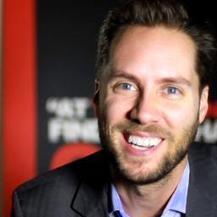 Your new post is loading...
 Your new post is loading...
Good riddance, 2016. For many of us, it was 12 long months full of bad news, fake news and surreal news, the most controversial election anyone can remember, plus too many other highlights and lowlights to mention. This very December, we've seen the many shades of orange upstaged by Pantone's Greenery, and we all know the color of the year is not a nod to hope about the climate or to anyone's envy of the Western world. Luckily, I can find solace in an area where my company definitely isn't green: spotting trends for the year ahead. Here at Havas PR, we devote the end of each year to spotting trends on the rise, and it's always interesting to look both ahead and back at the predictions that have proven out recently—more stringent legislation around brain damage suffered by football players (forecast in 2010); the universal brain-health movement (2009); and "Local is the new global" (2007). Here are a few of the trends we believe will directly impact marketers and advertisers in 2017 taken from our more in-depth report, "Blowback to the Future: The Trends That Will Shape 2017":...
Nearly 250 years later, in a world defined by technological change, we see the same fears and concerns. As of September 2015, Amazon had 30,000 Kiva robots automating its warehouses, increasing efficiency and reducing the need for pick-and-pack labor. And at the same time, demand for software developers continues to rise, as Marc Andreessen’s famous 2011 statement that “software is eating the world” becomes ever more true.
Over the next decade, we’ll see this pattern play out once more in the nascent Internet of Things (IoT). With an industry defined by “bringing physical things online,” many IoT business models are predicated on improving efficiency by eliminating labor. We see companies connecting garbage cans to the internet to improve the efficiency of deploying waste collectors — which means we’ll need fewer waste collectors. Drones are dramatically reducing the time it takes to survey a plot of land — which means we’ll need fewer surveyors. Every industry that involves electronics or equipment can expect to be disrupted in this way over the next 10 years.
So the same question that was asked in the late 1700s remains: Will this new technology eliminate jobs? No....
Consumers are increasingly monitoring and recording the minutiae of daily life, writes Nicola Kemp in the second of our 'Forward 50' trends series.
In the rush to laud the power of big data to drive business, many marketers are at risk of overlooking its biggest asset: its role in empowering consumers to measure, analyse and improve their lives via better use of data.
Despite lingering concerns over privacy, the Quantified Self movement is poised to become a growing force in marketing....
The rising popularity of the image in social media has further transformed the way we share our lives with one another.
... “This is a watershed time where we are moving away from photography as a way of recording and storing a past moment,” said Robin Kelsey, a professor of photography at Harvard, and we are “turning photography into a communication medium.”
Not surprisingly, the largest social networking companies are spending billions of dollars to be the place where consumers latch onto these visual nods. They know the stakes. While it might seem that Yahoo’s Flickr, Facebook, which also owns Instagram, and Twitter are fighting to become the ultimate online photo album or video vault, these companies are really fighting to provide the service for the newest way to communicate. If they miss that shift, they risk irrelevancy....
...Today I am surrendering my Facebook account, because my participation on the site is simply too inconsistent with the values I espouse in my work. In my upcoming book Present Shock, I chronicle some of what happens when we can no longer manage our many online presences. I argue - as I always have - for engaging with technology as conscious human beings, and dispensing with technologies that take that agency away. Facebook is just such a technology. It does things on our behalf when we're not even there. It actively misrepresents us to our friends, and - worse - misrepresents those who have befriended us to still others. To enable this dysfunctional situation -- I call it “digiphrenia” -- would be at the very least hypocritical. But to participate on Facebook as an author, in a way specifically intended to draw out the "likes" and resulting vulnerability of others, is untenable. Facebook has never been merely a social platform. Rather, it exploits our social interactions the way a Tupperware party does. Facebook does not exist to help us make friends, but to turn our network of connections, brand preferences, and activities over time -- our "social graphs" -- into a commodity for others to exploit....
|
The thing is: We'd never know it anyway.
In a note to clients out Tuesday, Bank of America Merrill Lynch said there's a 20%-50% chance that we're living in the matrix — meaning that the world we experience as "real" is actually just a simulation.
The firm cites comments from Elon Musk, Neil deGrasse Tyson, and Nick Bostrom's seminal paper on the issue as the basis for its 20%-50% view.
Here's BAML (emphasis added):
"Many scientists, philosophers, and business leaders believe that there is a 20-50% probability that humans are already living in a computer-simulated virtual world. In April 2016, researchers gathered at the American Museum of Natural History to debate this notion. The argument is that we are already approaching photorealistic 3D simulations that millions of people can simultaneously participate in. It is conceivable that with advancements in artificial intelligence, virtual reality, and computing power, members of future civilizations could have decided to run a simulation of their ancestors."
They don't look like Guardians Of The Galaxy-style superheroes.
... The porter's lodge is like an airlock, apparently sealed from the tribulations of everyday life. But inside the college, pacing the flagstones of what is called – all modesty aside – Great Court, are four men who do not take it for granted that those undergraduates actually have a future. They are the four founders of the Centre for the Study of Existential Risk (CSER), and they are in the business of "horizon scanning". Together, they are on alert for what they sometimes call "low-probability-but-high-consequence events", and sometimes – when they forget to be reassuring – "catastrophe"....
You probably thought your Uncle Henry was a little weird (and annoying) when he kept showing you how many more Nike FuelBand calories he needed to burn/earn to reach his preset daily goal. But what’s amazing is how that little wrist band with its tight feedback loop displaying points can actually motivate people to improve their lifestyle. Oh, it also makes a nice watch.
We’re at the dawn of a new industry loosely called "wearable technology" that may have reached $4.6 billion in sales around the world already this year.And Google Glass isn’t even for sale yet. Many geeks already are on board. The April Modis Geek Pride Survey of people aged 18 or over found that "61 percent of self-described geeks said they would buy and wear a smart watch," and "56 percent would do the same with smart glasses." Perhaps even more interesting, 37 percent of non-geeks were also interested in smart watches, and 35 percent were interested in smart glasses....But where is the trend going?
I was excited to sit down at the IBM Global Summit in Nashville with Jeremy Gutsche, an innovation expert, award-winning author, “one of the most sought-after keynote speakers on the planet, and the founder of TrendHunter.com, the world’s #1 largest, most popular trend spotting website. In this interview we discuss how Jeremy looks at building communities around the world that helps to spot and translate the largest trends around the globe.
The following interview has also been transcribed below...
If you’re in this line of work you can hardly open a business, technology or marketing trade, peruse your favorite site, or scan your Twitter stream without seeing some mention of the transformational changes being driven by hyperconnectivity. And despite all that, here’s a reality so surprising as to be staggering — 99% of our world is not connected yet… That’s all about to change. By various estimates, somewhere between 40 and 50 billion things will be connected to the internet (and each other) by 2020. And while that’s enough to get the gears spinning for the technologists among us, the human implications are just as enormous (actually, more so). Because of course, hyperconnectivity isn’t just about networking device-to-device but also person-to-device and ultimately person-to-person. When you take all of the possible combinations into account, technology expert Thomas Koulopoulos (in his recent bookCloud Surfing) envisions a potential 4.9 sextillion connections. Now this is getting interesting…
|



 Your new post is loading...
Your new post is loading...





















A look at what's ahead in 2017 from Havas PR